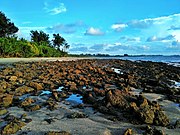Saint Martin Island is a small island in the northeastern part of the Bay of Bengal, about 9 km south of the tip of the Cox’s Bazar-Teknaf peninsula, and forming the southernmost part of Bangladesh. There is a small adjoining island that is separated at high tide, called Chera Dwip. It is about 8 kilometres (5 miles) west of the northwest coast of Myanmar, at the mouth of the Naf River.

History and description
Millennia ago, the island used to be an extension of the Teknaf peninsula, but portion of this peninsula later got submerged and thus the southernmost part of the aforementioned peninsula became an island, and was disconnected from the Bangladesh mainland. The island was first settled in the 18th century by Arabian merchants, who named it “Jazira”. During British occupation the island was named after the then Deputy Commissioner of Chittagong Mr. Martin as St. Martin Island. Local names of the island are “Narikel Jinjir which means “Coconut Island”, and “Daruchini Dwip” which means “Cinnamon Island”. It is the only coral island in Bangladesh.
Administration
Saint Martin Island
The island makes up the Saint Martin’s Union Parishad. It has 9 villages/areas:

- Paschim Para (Western Neighbourhood)
- Deil Para
- Uttar Para (Northern Neighbourhood)
- Majher Para (Middle Neighbourhood)
- Purba Para (Eastern Neighbourhood)
- Konar Para (Edge Neighbourhood)
- Nazrul Para (Neighbourhood of Nazrul)
- Golachipa (literally “narrow neck”)
- Dakkhin Para (Southern Neighbourhood.
Inhabitants
saint-martin-island

Most of the island’s approximately 3,700 inhabitants live primarily from fishing. The other staple crops are rice and coconut. Being very common on the island, algae are collected, dried, and exported to Myanmar. Between October and April, the fishermen from neighboring areas bring their caught fishes to the island’s temporary wholesale market. However, imports of chicken, meat and other foods come in from the mainland Bangladesh and Myanmar. As the centre and the south are mainly farmland and makeshift huts, most of the permanent structures are around the far north.
During the rainy season, because of the dangerous conditions on the Bay of Bengal, the inhabitants have no scope to go to the mainland (Teknaf) and their life can become dangerous. There is a hospital on the island, but in the past there has often been no doctor

